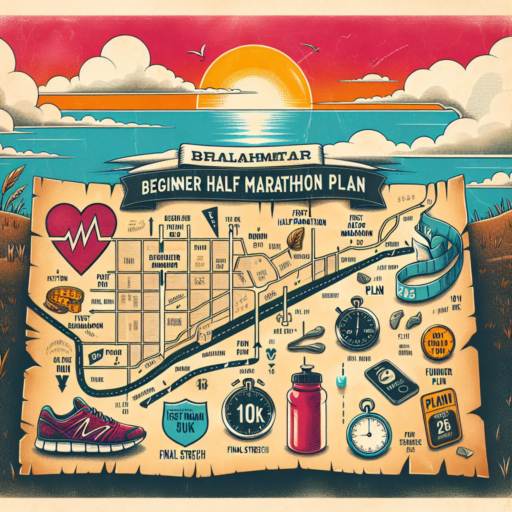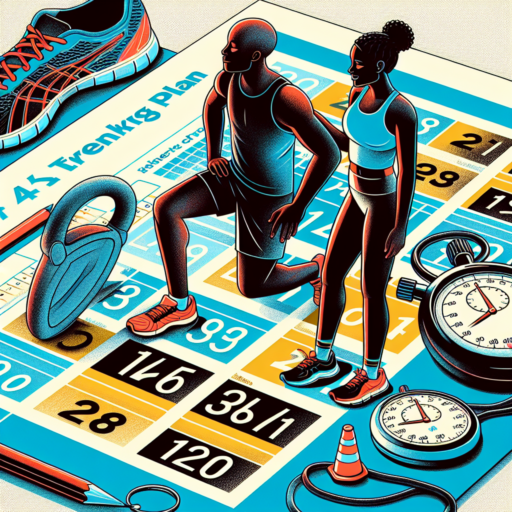Introduction to the 12-Week Half Marathon Training Guide
Embarking on a half marathon is an exhilarating challenge that requires not just determination but also a strategic approach to training. The 12-Week Half Marathon Training Guide is designed to take you from your current level of fitness to half marathon readiness. Whether you’re a novice runner or someone looking to improve your previous time, this guide offers a structured plan to achieve your goals.
Over the span of three months, this training guide will incrementally increase your running stamina, speed, and confidence. It breaks down the seemingly monumental task of preparing for a 13.1-mile race into manageable weekly objectives. You’ll discover how varying your workouts with combinations of long runs, speed work, and recovery days can significantly enhance your running efficiency and endurance. Moreover, each phase of the guide is tailored to gradually build up your body’s capability to withstand the demands of a half marathon, minimizing the risk of injury.
The beauty of the 12-Week Half Marathon Training Guide lies in its versatility. It is crafted to cater to the needs of individuals with diverse fitness backgrounds. By providing clear, easy-to-follow instructions and realistic training volumes, the guide ensures that runners can adapt the program to fit their personal schedules and physical conditions. This flexibility makes it a go-to preparcatory tool for anyone aspiring to cross the finish line of a half marathon.
Week 1-4: Building the Base for Half Marathon Success
The initial four weeks of training for a half marathon are crucial in setting a strong foundation for the rest of your preparation. It’s during this period that runners should focus on gradually increasing their endurance, strength, and flexibility, laying down the groundwork for more intense training in the weeks to follow. Understanding the importance of each of these components and how they contribute to your half marathon success is essential.
Increasing Endurance Gradually
Endurance building is at the heart of the first month’s training. It’s not about running far and fast early on, but about getting your body accustomed to running longer distances at a comfortable pace. Implementing a mix of short, medium, and long runs throughout the week ensures a gradual increase in stamina without overwhelming your body and risking injury.
Strengthening Your Body
Apart from running, incorporating strength training into your routine is pivotal during these weeks. Strength exercises, especially those targeting your core, legs, and glutes, will not only improve your running efficiency but also help in preventing injuries. This phase should not be about heavy lifting but rather about bodyweight exercises or light weights that enhance your strength gradually and sustainably.
Flexibility and Recovery
Lastly, never underestimate the power of flexibility and recovery. Integrating stretching and mobility workouts into your regime is as vital as the runs themselves. They ensure your muscles remain limber and resilient, thereby reducing the risk of injuries. Equally important is giving your body adequate rest; incorporating rest days into your training plan is integral to allow your muscles to recover and rebuild stronger.
No se han encontrado productos.
Week 5-8: Increasing Distance and Stamina
When entering weeks 5-8 of your running or training program, the primary focus shifts towards increasing both distance and stamina. This critical phase is designed to gradually build your endurance, allowing your body to adjust to longer distances without overwhelming it. It’s during this period that many athletes begin to notice significant improvements in their performance and overall fitness levels.
One effective strategy for increasing distance is to implement the 10% rule, which suggests that you should not increase your weekly running distance by more than 10% from the previous week. This approach helps in avoiding injuries and ensures a steady progression in your training. Additionally, incorporating long, slow runs into your weekly regimen can enhance your body’s ability to utilize fat as a fuel source, further boosting your stamina over time.
Improving stamina requires not only physical but also mental adjustments. Integrating interval training or tempo runs can be highly beneficial at this stage. These workouts challenge your body to adapt to different paces, improving your aerobic capacity and endurance. Rest and recovery, however, should not be overlooked. Taking adequate rest days and ensuring proper nutrition plays a crucial role in supporting your body’s ability to recover and grow stronger.
Nutrition and Hydration Tips for Half Marathon Training
Training for a half marathon is not just about the physical mileage you put in; it’s equally about properly fueling and hydrating your body. As you embark on this challenging journey, understanding the pivotal role of nutrition and hydration can significantly impact your training outcomes and race day performance. A balanced approach ensures you’re equipped to tackle both your long runs and recovery periods effectively.
Start by integrating complex carbohydrates into your diet, such as whole grains, legumes, and vegetables. These foods provide the sustained energy needed for long-distance running. Incorporating healthy fats and lean proteins is also crucial for muscle repair and recovery. As your training intensifies, so should your focus on meeting these nutritional needs. Moreover, timing your meals and snacks can optimize energy levels and prevent unwanted GI distress during runs.
When it comes to hydration, understanding your personal sweat rate is key. This knowledge will help tailor your fluid intake to avoid both dehydration and hyponatremia – a condition caused by excessive water consumption. Aim to drink water consistently throughout the day, not just during runs, and consider incorporating electrolyte-enhanced beverages during longer training sessions to replenish salts lost through sweat. Adjusting these hydration strategies according to the weather and your workout intensity is critical for maintaining balance.
Week 9-12: Tapering and Preparing for Race Day
As your training advances into the final weeks before the race, Weeks 9-12 are pivotal for tapering and final race day preparations. Tapering, the practice of reducing your training volume, allows your body to recover from the preceding weeks of strenuous activities and store energy for the big day. This critical phase is not about gaining more fitness but rather ensuring you’re in the best possible shape to achieve your race day goals.
Adjusting Your Training Regimen
Dialing back on the intensity and volume of your workouts is paramount during this period. It’s a time to focus on maintaining your fitness level, rather than trying to push for further improvements. Incorporating easy runs, gentle stretches, and perhaps some low-impact cross-training activities can help maintain your conditioning while reducing the risk of overtraining or injuries. The goal is to arrive on race day feeling rested, not lethargic, making this balance crucial.
Strategizing Your Race Plan
While physical preparation takes a step back, mental preparation comes to the forefront. Finalizing your race day strategy should involve setting realistic pace goals, understanding the race course, and planning your nutrition and hydration. It’s also a good time to check the weather forecast for race day and make any necessary adjustments to your gear and attire. Practicing visualization techniques and positive self-talk can also enhance your mental readiness, equipping you with the confidence to tackle the challenges ahead.
Remember, the tapering phase is an opportunity to reflect on the hard work you’ve put in over the weeks and to look forward to the culmination of your efforts. Embrace the reduced training volume as a crucial step toward achieving your best performance on race day. Proper nutrition, rest, and mental preparation during these last few weeks can make a significant difference in your overall race experience and outcome. So, approach this period with the respect it deserves, knowing every step taken is a step closer to crossing that finish line.
Essential Gear for Half Marathon Training
When embarking on the journey to train for a half marathon, selecting the right gear is as crucial as the training itself. Understanding the essential gear can transform your training experience from daunting to doable. This guide aims to highlight the indispensable items every runner should have in their arsenal to ensure a successful half marathon training experience.
The Right Pair of Running Shoes
Finding the perfect pair of running shoes is paramount for any runner. The ideal shoes will not only offer comfort but also provide the necessary support for your foot type and running style. It’s advisable to visit a specialty running store where you can receive expert advice on choosing a shoe that best fits your needs, potentially preventing injuries and enhancing your running performance.
High-Quality Running Apparel
Your choice of running apparel can significantly impact your training. Opt for lightweight, breathable materials that wick away sweat to keep you cool and dry. This is especially important for long-distance runs where comfort can greatly affect your performance. Additionally, wearing reflective gear during early morning or late evening runs is crucial for safety, ensuring you’re visible to motorists and other pedestrians.
Hydration and Nutrition Accessories
Proper hydration and nutrition are key factors in your training regimen and performance during the half marathon. Utilizing a hydration pack or belt can help you carry water or sports drinks easily, keeping you hydrated throughout your long runs. Similarly, energy gels or chews are essential for maintaining energy levels, especially during longer training sessions. It’s important to try different products during your training to find what works best for your body.
Cross-Training and Injury Prevention Strategies
Engaging in cross-training activities is a cornerstone of improving athletic performance and reducing the risk of injury. By incorporating a variety of exercises and workouts into your routine, you not only challenge your body in new ways but also allow different muscle groups to recover and strengthen. The essence of cross-training lies in its diversity, offering a comprehensive approach to fitness that helps in preventing overuse injuries commonly associated with repetitive strain and movements.
One effective injury prevention strategy is to focus on building core strength and stability. Core exercises play a pivotal role in cross-training, providing the necessary support for your entire body. A strong core not only enhances your balance and stability but also ensures that your movements are more controlled and efficient. This, in turn, significantly reduces the likelihood of injuries, especially those related to poor posture and imbalance.
Additionally, flexibility and mobility exercises should be integrated into your cross-training routine. Activities such as yoga, Pilates, or targeted stretching sessions work to increase the range of motion and elasticity of your muscles and joints. Enhanced flexibility contributes to a decreased risk of injuries by allowing your body to move more freely and adapt to various physical demands without strain. Remember, a flexible body is less prone to experience sprains and muscle tears, making these practices indispensable in your injury prevention arsenal.
Mental Preparation Tips for Your First Half Marathon
Stepping into the world of long-distance running requires not just physical readiness but a strong mental game as well. For many, the first half marathon is a monumental milestone, and tackling it starts with getting your mind in the right place. Here are some essential mental preparation tips to ensure you’re as ready as can be when race day arrives.
Set Realistic Goals and Expectations
Commencing your journey with attainable objectives is key. Reflect on your current abilities and set a target time that motivates you, yet is within reach. Remember, this race is more about completing than competing. Allow yourself the grace to adjust these goals as your training progresses, understanding that every runner’s journey is unique.
Visualize the Finish Line
Visualization is a powerful tool in an athlete’s arsenal. Spend time picturing yourself crossing that finish line – imagine the crowd, the sounds, and how fulfilling that moment will be. This mental exercise not only boosts your motivation but also helps in reducing pre-race jitters, making you more psychologically prepared for the challenge ahead.
Race Day: Strategy and Tips for a Successful Half Marathon
Running a half marathon is a challenging yet rewarding experience, requiring not only physical preparation but also a strategic approach to the race day itself. One key aspect of executing a successful half marathon is setting a realistic pace. It’s crucial not to start too fast, a common mistake many runners make. Instead, aim for a pace that feels manageable and allows for gradual acceleration, especially during the second half of the race. This approach helps conserve energy and reduces the risk of burning out early.
Staying Hydrated and Energized
Hydration and nutrition are critical components of any half marathon strategy. It’s essential to plan your hydration strategy, aiming to drink small amounts at regular intervals throughout the race. This will help maintain electrolyte balance and prevent dehydration. Additionally, incorporating energy gels or chews can provide a much-needed glucose boost. Plan to take these just before water stations to aid absorption and minimize gastrointestinal discomfort.
Navigating the Course
Familiarizing yourself with the race course beforehand can give you a significant advantage. Knowledge of upcoming hills, turns, and water stations allows for strategic pacing and nutrient intake. Moreover, visualizing yourself successfully navigating these challenges during your training can boost confidence and reduce race-day jitters. It’s also helpful to position yourself correctly at the start line based on your projected pace, avoiding the need to weave through slower runners.
Recovery and Beyond: What to Do Post-Half Marathon
After completing a half marathon, your body has undergone significant stress, and it’s crucial to focus on recovery to ensure a safe return to training and improve overall performance. The immediate steps you take post-race play a pivotal role in how quickly and effectively your body recuperates. This period is not just about physical recovery but also about understanding the accomplishments you’ve achieved and setting the stage for future goals. Let’s delve into effective strategies that help navigate the post-half marathon phase, ensuring your recovery is as efficient as your preparation.
Initiating Post-Race Recovery
Initial recovery starts with rehydration and refueling within 30 minutes of finishing the race. Consuming fluids and foods rich in carbohydrates and protein helps to replenish glycogen stores and repair muscle tissues. Activities like a gentle cool-down walk, followed by stretching major muscle groups, can aid in reducing stiffness. Equally important is listening to your body’s signals: rest should be a priority, and any persistent pain should prompt a consultation with a healthcare provider.
Strategizing Long-Term Recovery
Long-term recovery transcends immediate actions and involves a strategic approach over the weeks following the race. Gradually reintroducing running through a reverse taper method can help your body adjust without overwhelming it. Incorporating cross-training activities, like swimming or cycling, can maintain your fitness level while giving your running muscles the necessary break to fully recover. Emphasizing flexibility and strength exercises will not only aid in recuperation but also in injury prevention for future races.
Understanding the importance of mental recovery is as crucial as addressing the physical aspects. Reflecting on your half marathon experience and setting new goals is a key component of staying motivated and focused. Whether your aim is to improve your time, increase your distance, or simply maintain a healthy lifestyle, keeping a forward-looking mindset is vital. The journey doesn’t end at the 13.1-mile marker; it evolves into an ongoing commitment to your physical and mental well-being.




